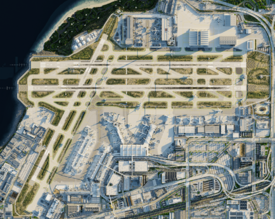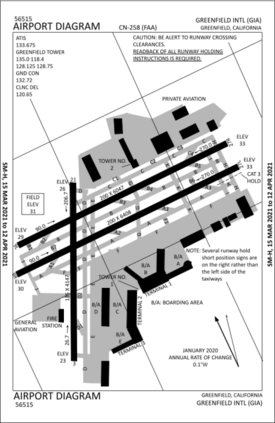Greenfield International Airport
Greenfield International Airport (IATA: GIA, ICAO: KGIA, FAA LID: GIA), typically referred to as Greenfield Airport, is an international airport located on the northeast side of Greenfield, California. Operated by the Greenfield Department of Aviation, and covering over 4 kilometers of land, GIA has non-stop flights to over 130 destinations in North America, South America, Europe, Africa, Asia, and Oceania as of 2022.
Greenfield International Airport | |||||||||||||||||||
|---|---|---|---|---|---|---|---|---|---|---|---|---|---|---|---|---|---|---|---|
 | |||||||||||||||||||
 Aerial shot of Greenfield International Airport | |||||||||||||||||||
| |||||||||||||||||||
| Summary | |||||||||||||||||||
| Airport type | Public | ||||||||||||||||||
| Serves | Greenfield Metropolitan Area | ||||||||||||||||||
| Location | Lannex, Greenfield, U.S. | ||||||||||||||||||
| Opened | 0.5.4 | ||||||||||||||||||
| Hub for | |||||||||||||||||||
| Focus city for | |||||||||||||||||||
| Elevation | 31 ft / 9 m | ||||||||||||||||||
| Coordinates | 3600, -1900 | ||||||||||||||||||
| Map | |||||||||||||||||||
 GIA Airport Diagram | |||||||||||||||||||
| Runways | |||||||||||||||||||
| |||||||||||||||||||
GIA began as an airfield for manufacturing C-54 military transports during World War II. As one of the first airports developed after the war, GIA's innovative design pioneered concepts such as concourses, direct highway access to the terminal, jet bridges, and underground refueling systems. GIA became famous during the jet age, holding the distinction as one of the world's top fifty busiest airports from 1963 to 1998, reaching 27th place in 1994. In 2019 it was the world's ninety-sixth-busiest airport, serving 20 million passengers.
GIA also serves as the primary western hub for SkyLiners Airlines, and is the companies second largest hub.
History
Establishment
Starting in 1923,, the California National Guard used the present airport site (known then as the Lannex lowlands) as a training airfield. The site was then dedicated as the "Greenfield Municipal Airport" by then Mayor in 1926, but it had no proper terminal building until 1939, many airlines choosing to utilize Los Angeles, San Francisco or San Diego instead. Once Greenfield's terminal as completed, multiple airlines including Skyliners and Unified began service here.
As its terminal was completed, two runways, 3/21 and 09/27, were built to meet the demand for land-based planes making operations at Greenfield.
On August 17th, 1942 the airports weather station became the official point for Greenfield weather observations and records by the National Weather Service.
World War II use
During World War II the United States Navy used the airport as a training facility as well as a construction site for the manufacturing of the Douglas C-54 Skymaster military transports. A major defense contractor and contributor to World War II transport production, C54 Aircrafts, later known as Derksair, had their headquarters on the border of the Municipal field, and built many of their military aircraft their. Derksair used the airport for test and delivery flights from 1935 to 1952 when their main facility burned to the ground.
Because of its location next to the Pacific ocean, it was believed that the airport could be a target for Japanese retaliation especially after Pearl Harbor. Special care was taken to protect the construction facilities including building a fake neighborhood on the roof of the warehouse. This town known as Little Lannex was made of wood and fabric and hid the massive construction hangar from the sky. However Greenfield never saw any combat during the war, and in a cruel turn of fate the supplies on the roof are believed to have caused the fire that burned down the facility and caused Derksair to go out of business at the end of the war. The vacant space left by the hangar was used in later years to develop jet age terminals.
Passenger service and growth
Greenfield Municipal became Greenfield International in 1946, when Nordair began direct flights to here from Vancouver (YVR) with their newly delivered Douglas DC-4s. The original terminal 1 did not have jet bridges and thus many felt a new terminal was needed to bring Greenfield into the jet age. A new terminal opened in 1955 which is currently the oldest existing terminal at the airport now called Terminal 3.
Terminal 1 and 3 modernization was completed in 1971, Terminal 2 opened in 1974 while the concourse opened in 1977. The $500 million expansion was one of the largest single building projects ever taken on by the city. In 2015 the airport finished construction on their brand new international terminal at the location of the old terminal 1. Many preservationists where angry at the destruction of the historic terminal building, but their was realistically no way the facility could have been outfitted for the modern needs of passengers and airlines. The new terminal 1 serves as the international terminal and holds the US customs. During this time a baggage system modernization occurred across the entire airport.
In the 1980s GIA hosted hubs for Skyliners and Vision Airlines. The Airline Deregulation Act of 1978 allowed regional carrier Altis (later renamed Speedfly Airlines) to create a small hub at GIA. Skyliners became the dominant carrier at GIA in the 1980s and 1990s and shifted most of its operations from LAX to GIA in 2002. As of 2015, GIA was Skyliners second largest hub overall.
In 1997 the California Department of Transportation and several U.S. federal government agencies selected a route to connect the three terminals to the nearby expressway. Nearby stakeholders especially local hotel owners objected to the proposed routing, saying it would take all the traffic off the local roads and loose business. Most notably two large hotels, the Botanist, and the Wheaton had to be demolished for the highway connection.
In 2022 the new multimodal facility was completed. This facility includes thousands of parking spaces to serve 10+ rental car services in an effort to centralize all of the services. The airport people mover was also extended to the facility, which sat next to the Lannex regional rail station, meaning passengers could now travel directly from the regional rail station to the airport.
Future
Like many airports across the nation, the aging terminal 2/3 are causing delays. Current plans involve the continued modernization of the baggage systems which started in 2012. A new terminal end is being built at the end of terminal 3, expanding the amount of gates to the terminal by 4. Minor updates to the facility will occur along side the construction.
However, with airlines replacing traditional hub-and-spoke models with point-to-point models, large aircraft such as the 787 Dreamliner or the A350 will need to be able to land here. Unfortunately, runway extensions proposals have been rejected due to concerns regarding noise pollution in Lannex and aquatic conservation in the western side.
Build History
0.5.3
Initial admin planning began at the end of 0.5.3.
0.5.4
The development of the Greenfield International Airport officially started in mid 2019, with the release of the plans for Los Llanos and Rockwell to the admin team by THEJESTR11. The original airport plan was nothing more then three parallel runways and a bunch of open grass space. Admin 56515 took the lead on developing a more detailed plan for the airport and eventually ended on a 2 parallel runway configuration with a crossing angled runway. from the very beginning the goal of the structure was to create an airport that didn't conform to Minecraft's grid. This meant that terminals would be at realistic angles from each other. Much of the early planning and laying out work was done by 56515. The road systems as well as the runway work was primarily done by Admins Staples and NJDaeger. Of the three terminals, it was decided that 56515 would tackle terminal 1, Staples terminal 2, and past Admin JacobKazias terminal 3. As the project developed many others assisted in the build process, especially with the interiors of terminals and the development of the cargo center. Eventually Architect Dasky joined the build team and quickly made some important changes to the airport to make it more realistic and in line with real life airports because of his real life experience. Together, with the help of the rest of the build team, Greenfield International Airport has become one of the most impressive parts of the project.
Facilities
Terminals
Greenfield International Airport has three public terminals named Terminal 1, 2 and 3. Terminal 2 and 3 hold the majority of domestic flights and are older, being built in the 1970s and 1980s. Terminal 1 was rebuilt in 2015, replacing the majority of the terminal, keeping one terminal leg of the original 1970s building. All international flights and some domestic flights depart from Terminal 1.
Runways
Greenfield International has 3 runways, 09R/27L, 09L/27R, and 03/21, all made from concrete. The 27L/R parallel runways have a separation of only 208 meters (682 feet), too little for a conventional SOIA approach to be carried out; a SOIA approach requires runways to be at least 229 meters (750 feet) apart. Therefore, at peak hours for aircraft movements where parallel takeoffs/landings are used, it is temporarily a Category C airport, meaning that pilots have to carry out special training in a simulator to land when parallel landings are in effect.
It is notable as one of the high-traffic international airports with unusually short runways, allowing aircraft up to the Boeing 767-200 or Airbus A330-200 to take off and land at maximum takeoff and landing weights (or other larger aircraft albeit with highly reduced fuel and capacity). For context, a fully loaded and fueled Boeing 747-8 requires about 10,000 feet of runway to lift off the ground, which is about 58% more distance than the longest runway here.
Due to this, most international traffic comes from Los Angeles or San Francisco which are both roughly 3 hour drives away. If a relatively large plane does decide to land here, they must use a high autobrake setting, and if one takes off here, full thrust is always required (regardless of runway condition) and the brakes are required to be held onto until the engine reaches full thrust.
There have been cases of runway overruns due to unfavourable conditions resulting from the short runways, most notably Golden Pacific Flight 008 which overran the runway during a strong crosswind and crashed through the eastern airport fences and onto I-205. This prompted a complete closure of said section for 2 weeks and resulted in heavy traffic in the Lannex roads due to diversion.
Simultaneous Offset Instrument Approach
The airport runways that head west were granted SOIA compliant in 2016 after a slightly intense vote in the FAA administration, now being one of the 3 airports in the US actively conducting SOIA approaches (San Francisco and Cleveland International).
However, such approaches may not be used after sunset (times are directed by ATC) after the Vision Airlines Flight 3015 incident. In 2021, due to concerns regarding wake turbulence from such little runway separation, parallel landings (with SOIA approaches) and takeoffs may not be carried out when resultant crosswinds are over 10 knots.
Hotel
The airport hotel, named GoFly, was opened in 2013. Construction originally started in 2006, but the economic slowdown has halted its construction due to a large cost overrun. It has 11 floors, and is within a short walking distance to the airport terminals.
Ground transportation
Greenfield International Airport has extensive ground transportation options including a direct connection to the city subway system, the Rockwell/Lannex LRT, the Lannex rail station, direct highway connection, and a bus terminal.
GIA is directly connected through the intersection between I-10 and I-205, which is then roughly a 10 minute drive to city center, assuming no traffic.
Cargo facilities
Greenfield International has 3 cargo facilities.
The Southern facility is located to the south of 9R/27L, which has 3 stands for large aircraft like the Boeing 747-8F or the Antonov An-124 Ruslan, 3 stands for medium aircraft like the MD-11F, and one for small aircraft like a 737-800BCF. It is directly accessible from the roads in Lannex.
The Northern facility is located to the north of 9L/27R and is next to the airplane hangars, which has 6 stands for medium aircraft like the aforementioned MD-11F.
There is also an unnamed cargo facility to the right of the threshold of Runway 03, which can accomodate 1 large cargo plane or 2 small cargo planes.
Other facilities
To the southeast of the threshold of 27L, there is a preserved DC-10-30 which is accessible to the public (when?). There is also a business aviation facility, accessible from North Lannex, that can hold 9 private jets (wingspan limit?). There is also a general aviation facility that is to the left of Runway 03, which is open from [insert time here].
Airlines and Destinations
Passenger
Insert table about airlines and destinations here.
Cargo
Insert table about airlines and cargo destinations here.
Ground handling companies
There are four ground handling companies operating at Greenfield International Airport providing passenger, baggage, cargo and ramp services to airlines. They are:
American cargo handling company US Across also operates ramp services and a cargo facility at the airport.
Statistics
Top destinations
Insert table on top destinations of the airport. Domestic and international.
Accidents and incidents
- Unknown date, 1973: a Lockheed Electra operated by the Marine Corps crashed into the bay shortly after takeoff. The pitch control system of one of its propellers is said to have failed. All 8 personnel inside the aircraft perished.
- June 6, 1984: A Vision Boeing 737-200 suffered a double bird strike during takeoff. The crew was able to use the APU to restart one of its engines shortly after it failed, and it returned for a safe emergency landing about 30 minutes after takeoff. Nobody was injured.
- March 14, 1996: A Golden Pacific 777-200ER overran the runway during landing due to pilot error in inclement weather and crashed into I-205. All 192 people in the aircraft died, making for the deadliest aviation accident in all of California.
- September 1, 2017, Vision Airlines Flight 3015: Pilot error led to the wingtips of a Vision Boeing 737 to get within 100 meters of the wingtips of a Boeing 757. Due to poor visibility, the 757 did not initiate a go around and landed as usual, causing its downwind wake turbulence to affect the 737. It suffered a wingstrike on an attempted landing and had to go around then make a successful second landing. One minor injury was reported. This accident made it so that parallel landings may not be carried out at night, as directed by ATC. Later investigations revealed that external radio signal jamming was affecting the ILS' capability to communicate with the pilots, which caused this incident.
- January 23, 2021: A Boeing 737-800BCF had to make an emergency landing after its landing gear failed to retract after takeoff.
Gallery
test